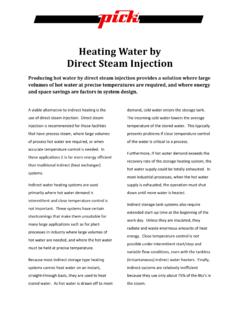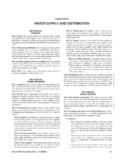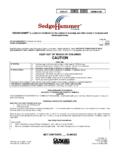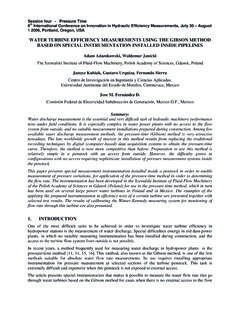Transcription of DSI Hot Water Systems for Jacketed Heating R4 2
1 DIRECT STEAM INJECTION HOT Water Systems FOR Jacketed Heating By Philip Sutter Pick Heaters, Inc. INTRODUCTION Many process plants currently use steam or hot Water to heat Jacketed devices such as tanks, kettles, dryers, reactors, glass lined vessels, or similar adaptations such as coiled tubing placed inside or outside tanks or vessels. In this article, we will take an in-depth look at the advantages and disadvantages of steam and hot Water for Jacketed Heating , and compare indirect and direct steam injection Systems for making hot Water . In Heating applications where processes require operating temperature up to 350 F (177 C) steam is often the first Heating medium considered because it is readily available.
2 However, hot Water should be given equal consideration. ADVANTAGES AND DISADVANTAGES OF STEAM Figure 1 illustrates a typical Jacketed Heating system using steam. Because it is readily available and easy to apply, steam is often used for Jacketed vessel Heating . Steam provides quick heat-up and it is predictable 100 PSIG (7 BARG) saturated steam is always 338 F (170 C) with 1,189 BTU/lb total heat content. Despite its advantages, steam has several shortcomings. It does not offer precise temperature control, and energy transfer is not uniform.
3 Due to uneven distribution, higher temperature steam typically collects in the upper portion of the jacket, with cooler condensate collecting near the bottom. Internal hot spots also develop around hot steam inlet nozzles, adding to the problem of uneven product Heating . This increases the likelihood for product burn-on and local overheating. Furthermore, a steam trap is a necessary component of a steam-heated Jacketed vessel. It allows condensed steam to exit the jacket, making room for more steam. If improperly sized or poorly maintained, energy will be wasted and temperature control will be compromised, which frequently results in damaged product or lower product yields.
4 Reactions requiring both Heating and cooling are cumbersome for the steam-heated system because of the dramatic temperature difference between the steam and the cooling Water . At the conculsion of the Heating cycle all steam and condensate must first be driven out of the jacket prior to introducing cooling Water . This is a time-consuming process that is often not done completely. The problem is most severe with glass-lined reactors, which may be damaged by thermal shock and steam hammer if cooling Water contacts residual steam in the jacket.
5 Currently, an increasing number of process engineers are switching from steam to hot Water for Jacketed Heating . There are several basic reasons for this trend: The temperature in the jacket can be controlled much more accurately with hot Water than with steam. This higher degree Pick Heaters, Inc. 2010 Page 2 of control protects against damage to or loss of product through overheating. Hot Water distributes heat more evenly than steam. This eliminates hot spots which often cause product to bake onto the walls of the vessel, and at worst, ruin the entire batch.
6 Hot Water ensures a better quality end product. This is particularly important in processes requiring very precise product temperature control. In critical processes utilizing glass-lined reactors, steam can shock and damage the lining. Hot Water allows smooth transitions from Heating to cooling with no thermal shock. In addition, many are switching to direct steam injection (DSI) Systems to create the hot Water for several basic reasons: With an advanced-design steam injection Heating system , the temperature of the process can be adjusted at any predetermined rate on any desired time cycle.
7 A steam injection hot Water system can be programmed to heat then cool a process by stopping the Heating cycle and introducing cooling or tempered Water into the jacket at any desired rate and temperature. In this system the condensate (from the steam that was injected) leaves the circulating loop through a back pressure relief valve at the lowest temperature after all the possible heat has been extracted. In a steam system , on the other hand, condensate at a much higher temperature must be returned to the boiler in a condensate return line with its inherent heat losses.
8 ADVANTAGES AND DISADVANTAGES OF HOT Water The use of hot Water to heat reactor vessels solves many of the problems associated with steam. The jacket temperature can be controlled more accurately with hot Water because hot Water distributes heat more evenly over the wetted surface of the vessel. This eliminates hot spots, which can cause the product to burn onto the walls of the vessel and potentially ruin the entire batch. By eliminating burn-on, product quality is protected and product filtering and costly clean up time are minimized. Hot Water offers a wide range of operating temperatures because when pressurized, Water will remain in the liquid state and not flash into steam.
9 For example 72 PSIG (5 BARG) Water can be heated in a pressurized circulating loop to 310 F (154 C) without boiling. The process can be gradually ramped up or down to desired temperatures, eliminating the potential of thermal shock. For processes requiring both Heating and cooling, hot Water can be adjusted at a predetermined rate on a desired time cycle through the use of cascade or heat/cool temperature control loops, or an in-plant PLC or DCS. A hot Water system can be programmed to heat, hold, then cool a process by introducing cooling or tempered Water into the jacket at a controlled rate and temperature without having to stop the process as when using steam.
10 In addition to offering precise temperature control, Water is readily available, easy to handle, non-flammable, safe to the environment, and inexpensive as compared to heat transfer fluids. What is the downside of using hot Water in Jacketed vessels? The product heat-up time using hot Water will not be as rapid as it is with steam. However, once up to temperature the steam heated system may be difficult to keep from overheating. Another limitation is that the jacket Water temperature cannot equal or exceed the saturated temperature of the steam supplied to the system .









